Disclosure: This article may contain affiliate links. If you decide to make a purchase, I may make a small commission at no extra cost to you.
Everyone wishes to have clear, smooth beautiful skin and to remain young and beautiful for longer. Some people seem to have great skin no matter what they do, while others struggle and use countless products just to keep it looking good. I’m one of them who uses premium skincare products like Skinceuticals to help with skin aging. But I know that it’s just as important to treat your skin from the inside as it is on the outside.
Eating healthy foods on a vegan diet can make you look younger by providing nutrients to the skin, lowering inflammation, and increasing blood flow and oxygenation to the tissues. In this article, I will share with you what to eat to look younger than your age.
The foundation of healthy skin is in the diet: you to primarily focus on plant foods, whether it is fresh fruits, vegetables, nuts, or seeds. It’s not hard to look 10 years younger than your age if you take care of yourself. And of course, the longer you look after your health, the longer you will stay looking young!
Best Foods to help you stay young looking
Sweet potatoes
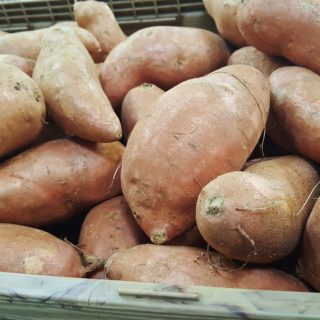 Sweet potatoes are commonly consumed in some parts of the world such as Asia. They are especially popular in Okinawa. In the west, white potatoes are usually a staple of the diet; unfortunately, white potatoes have a high glycemic index and a poor nutritional profile.
Sweet potatoes are commonly consumed in some parts of the world such as Asia. They are especially popular in Okinawa. In the west, white potatoes are usually a staple of the diet; unfortunately, white potatoes have a high glycemic index and a poor nutritional profile.
Adding sweet potatoes to your diet would give you significant benefits and boost up the nutritional content of your diet considerably. Sweet potatoes are high in beta-carotene, which is converted by the body to retinol (vitamin A).
Beta-carotene also acts as a powerful antioxidant against the singlet reactive oxygen species which can provoke cellular damage to proteins and lipids in the body. Plants produce these carotenoids to neutralize the production of ROS from ultraviolet light.
Consuming sweet potatoes will give you enough beta-carotene so that it immediately gets to work in quenching free radicals and will be stored within fat cells in your skin – so to give you some protection against ultraviolet light damage (1). 100 grams of sweet potato will give you approximately 9444 μg of beta-carotene is one of the richest sources of this Vitamin A precursor. Kale and Carrots are two other vegetables that offer significant amounts of beta-carotene.
The sweet potato is also high in Vitamins B5, B6, and Vitamin C. Eating sweet potatoes may cause the skin to change color if your body becomes saturated. This is completely harmless and is nothing to worry about.
It is known as carotenemia and will go away once consumption is reduced. Moderate consumption of carotenoid-rich foods will give you a healthier looking complexion – and protect you from the harmful effects of the sun.
Tomatoes
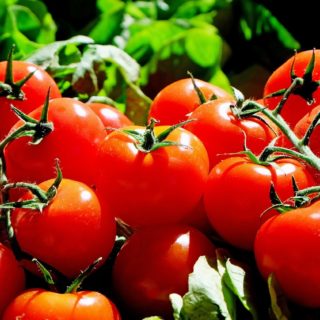
Tomatoes are the world’s most popular fruit and are used in many dishes. Tomatoes can be eaten raw or cooked: they are delicious either way!
Tomatoes also happen to be very good for our health because a compound is known as lycopene that is found in their skin.
Lycopene belongs to the carotenoid family – but unlike beta-carotene, it cannot be converted to vitamin A. Once lycopene has been absorbed it is then transported by lipoproteins and accumulates in various organs where it can offer protection from oxidative stress.
When you eat this fruit, the lycopene that you get from it is stored in fat cells in your body, where it can quench twice as many singlet oxygen molecules than beta-carotene. Lycopene is transported to the skin, giving you increased protection against both UVA and UVB rays.
In one study, researchers recruited 20 people and looked at the effect of giving 50 grams of tomato paste with 10 grams of olive oil to participants, and compared them with a group who had just received olive oil.
In the study, participants were exposed to UV light, and then the researchers looked at the protection gained from tomato paste consumption.
It turned out that those who were fed the tomato paste had a 33% increase in protection against sunburn (2). They also saw an increase in skin procollagen, which is a precursor to collagen.
In a separate study, the concentration of lycopene in the skin was also correlated with skin smoothness (3).
Lycopene is more bioavailable when tomatoes have been cooked or processed, therefore I recommend cooking them or using tomato-based products such as ketchup, tomato sauce, tomato paste, and salsa.
It’s very important that they are consumed with some type of fat. Olive oil would be fine, but you can also use avocado to enhance absorption significantly.
By adding fruits such as avocado, you will also increase the carotenoid content of your meal as avocado itself is itself quite rich in alpha-carotene, beta-carotene, lutein, zeaxanthin, among others (4).
Apart from tomatoes being an excellent source of lycopene, they are also high in beta-carotene, Vitamins C, and K. They also contain a high amount of potassium.
Avocados
Avocados are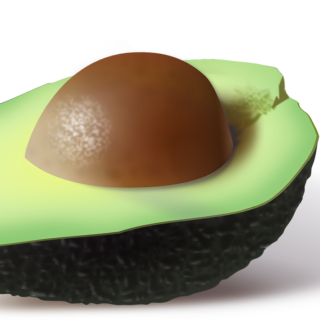 relatively high in calories because of the amount of fat they contain.
relatively high in calories because of the amount of fat they contain.
In fact, 75% of the calories in avocado is from fat, primarily healthy fats like oleic acid, which is a monounsaturated type fat and quite healthy for you.
Avocados are also packed full of nutrients and contain many compounds that may be beneficial to the skin like alpha-carotene, beta-carotene, and lutein.
Just one avocado contains approximately 160 mg of alpha-linolenic acid, which is beneficial in reducing inflammation.
By consuming alpha-linolenic acid (or applying directly to the skin) you can change the fatty acid composition of the skin.
This has been shown to increase the turnover of the stratum corneum, and thus speed up the removal of sun-induced hyperpigmentation of the skin by suppressing further melanin production and because of an enhanced removal of melanin pigment from the epidermis (4).
Higher intake of omega 3 fatty acid consumption has also been linked to less photoaging (6).
Avocados can be added to salads, smoothies, spread onto wholemeal bread, or even eaten on their own. They are high in Folate, B5, B6, Vitamin C, K, and also contain a respectable amount of potassium.
They also supply you with almost 40% of your recommended daily fiber intake.
Make sure you consider adding this fruit as one of your dietary staples!
You can find more sources of omega 3 here.
Green tea
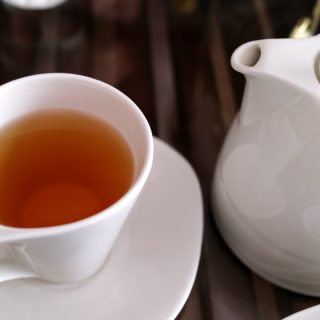
Green tea is one of the most popular beverages in the world and comes in many different varieties.
Green tea is also one of the most researched because of the reported health benefits from epidemiological studies, which suggested green tea was associated with lower risk of various diseases such as diabetes, cardiovascular disease, stroke, and even some cancers.
A compound which goes by the name Epigallocatechin Gallate (EGCG) is the main catechin that is thought to be responsible for these health benefits.
Animal and human studies show that green tea can reduce UV-related damage to the skin and immunosuppression (7).
In a small pilot study that lasted 8 weeks, volunteers were given sunscreen, 10% GTE Cream, and 300 mg (twice a day) of green tea extract, and then histological effects were reported after some time.
They noted that elastin content in the control group had decreased during the period of the study, while in the green tea group, elastin had increased (figure 1).
However, due to the short period of the study, no clinical changes in the appearance of the skin were observed (8).
In another study published in 2009, researchers recruited 56 women aged 25 to 75 and randomized the groups.
One group received 250 mg Green Tea Polyphenols (GTP) and the control group took a placebo. Both groups were instructed to take these twice a day.
They had an assessment at various points in the study, and the GTP group had significant improvements in the overall solar damage by 6 months. They also had an improvement in erythema and telangiectasias at 12 months.
The placebo group did not experience these improvements at any point in the study. At 24 months into the study, the researchers were unable to note any significant differences between the GTP and control groups due to the high dropout rate in the study.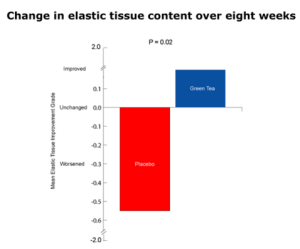
A separate study that was reported in the journal of nutrition showed many clear benefits of green tea when they looked at 60 females aged 40–65 that were randomized into the intervention or control group.
The intervention group received 1402 mg of total catechins per day in the form of a beverage, and the placebo group received a similar beverage that did not contain any catechins.
During the study, the researchers measured the level of Flavanols in the blood.
They also looked at skin photoprotection, skin structure, and skin function, with measurements taken at week 0, week 6, and week 12.
Looking at measurements of flavanols in the blood, they were able to see if the groups were adhering to drinking the GT beverage.
By 12 weeks were significant differences in blood concentrations of the main catechin (EGCG): GTE 345 ± 191** vs 33 ± 60* nmol/L for the controls indicating compliance (10).
In the GT group, the mean Δa-values decreased by 16 and 25% from baseline by 6 and 12 weeks.
This indicates increased photoprotection in the intervention group. No changes observed in the control group.
Biological elasticity increased by 3.9% after 12 weeks in the GT group. Skin density significantly increased by 7.7% after 12 weeks, whilst skin thickness remained the same.
The GT group also had reductions in skin roughness (−16%), volume (−20%), and scaling (−25%).
Skin hydration also was increased by 9% in week 6 and 17% after 12 weeks. The transepidermal water loss had decreased by 12% compared with the baseline which may indicate increased barrier protection of the skin in the GT group.
Furthermore, dermal blood flow increased 40% by week 6 and 29% by week 12, compared with baseline values.
Oxygen saturation increased from ~30% at baseline to 40% by week 12. Blood flow and oxygen saturation remained the same for the control group.
In contrast with previous studies, this study of shorter duration was able to find significant improvements after just 12 weeks. This could indicate greater compliance or that the consumption of green tea should be spread out throughout the day to observe the greatest benefit.
Participants of future studies involving green tea extract or beverages should be instructed to not consume milk or any products that contain casein as it is able to block some of the benefits by green tea (11).
There is some evidence that polyphenols have a high binding affinity for proteins such as caseins.
For maximum benefits to be observed, a much longer study would need to be performed in order to see visible differences between groups.
I suggest that people drink up to 5 – 10 cups of green tea per day to get the most benefit.
One animal study had shown that by adding piperine to green tea, the bioavailability of GT catechins was increased significantly (12).
Soy milk
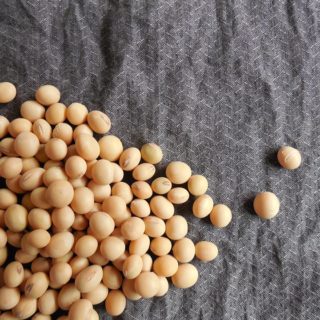 Soy milk provides you with all of the essential amino acids that are needed by the human body to be healthy.
Soy milk provides you with all of the essential amino acids that are needed by the human body to be healthy.
In several studies, consumption of soy foods or its extracts has been associated with improved skin in postmenopausal women.
It’s believed the reason for this is because soy contains phytoestrogen compounds known as genistein and daidzein, which are able to act on estrogen receptors in the body. However, these plant estrogen-like compounds are much weaker than estradiol.
Gut flora is also able to convert daidzein into an isoflavone called equol, which also has benefits to health, but only some people are able to do this conversion.
The average annual consumption of soybeans in Japan is much higher and is thought to be one of the reasons why they have less breast, colon and prostate cancers (13).
In a pilot study conducted in 2009, researchers had shown that postmenopausal women taking 100mg/day concentrated soy extract for 6 months exhibited significant improvements in skin health.
In the treatment group, there was an increase in epidermal skin thickness by 9.46% and the amount of collagen was increased in 86.2% of the women. 75% of them also saw an increase in elastic fibers.
The number of blood vessels also had significantly increased (14).
Another double-blind, placebo-controlled trial was conducted to look at the effects of isoflavones on the skin of middle-aged women.
The intervention and placebo group were both assessed at various points in the study and measurements were taken on various skin parameters. The test group showed a significant improvement in fine wrinkles by week 12 and increased elasticity by week 8 (15).
Chocolate
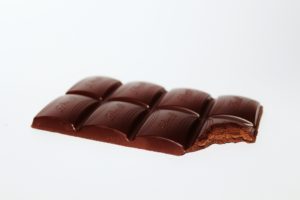
Chocolate, who doesn’t love it? Well, here is some good news! Cocoa is linked with an improvement of skin health.
A study published in the Journal of Nutrition showed that women who consumed cocoa powder for 12 weeks had an improvement in skin photoprotection, increased skin thickness, increase blood flow to cutaneous and subcutaneous tissues.
The mechanism behind these improvements is likely through the ability of cocoa to induce nitric oxide vasodilation (16-17).
They also saw an increase in skin density, skin hydration, and a decrease in transepidermal water loss in the high flavonol group indicating improved skin barrier function.
Both groups had received cocoa powder, but these benefits were only seen in the high flavanol group.
Look for a product that has more than 70% cocoa solids if you want to try to improve your skin.
Kale
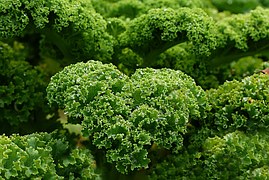 Kale is a green leafy vegetable and is part of the cruciferous family. It boasts an outstanding nutritional profile and it’s probably of the most nutritious foods you can eat.
Kale is a green leafy vegetable and is part of the cruciferous family. It boasts an outstanding nutritional profile and it’s probably of the most nutritious foods you can eat.
It is very high in beta-carotene, vitamin C, and Vitamin K.
Kale is also an excellent source for bioavailable calcium! Just 1 cup will supply with almost 10% of your calcium needs.
You will also get a significant amount of lutein (26.5 mg/ cup), which is very beneficial to the skin.
A study in 2007 showed that oral supplementation of lutein improved photoprotection by 2.5 times.
They also saw a 56% increase in skin elasticity and a 60% increase in skin hydration after 12 weeks.
Skin lipid levels were increased by 46% and lipid peroxidation was decreased by over 60% in the oral supplementation group (18).
Regular consumption of kale will give you enough lutein see the reported benefits. If you include Kale in your diet, make sure that you eat it with some fat as this increases absorption.
It’s very easy to regularly consume this amount if you were to put it in a green smoothie.
Red onions
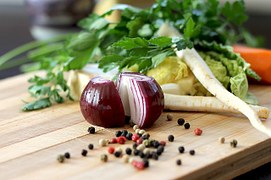
Red Onion belongs to the Allium family and it’s an excellent source of quercetin.
Quercetin is a yellow pigmented compound called a flavonoid.
It has a long half-life in the body and has strong anti-inflammatory properties as well as acting as a good antioxidant and antihistamine.
Most quercetin in red onions can be found in the outermost skin layers.
Apples also have a significant amount of quercetin content and have been found to be associated with less skin wrinkling (19).
To get the most benefit from red onions it is best to eat them raw.
Olive oil
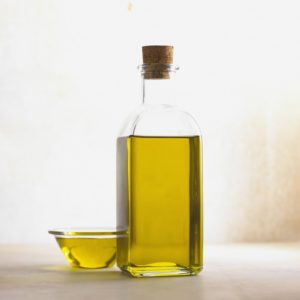
Olive oil is high in oleic acid, which is a healthy monounsaturated fat.
Olive oil contains numerous polyphenols, anthocyanidins, flavonols, flavonoids, and other compounds that are thought to be beneficial to health.
Some of them have strong anti-inflammatory effects by blocking proinflammatory molecules such as TNF-a, IL1-b, and IL-6. Olive oil also inhibits two important enzymes COX-1 and COX-2, which are involved in the process of inflammation.
Olive oil consumption has been linked to a decreased severity of photoaging among men and women according to a study that was published in 2012.
The study found that high olive oil intake was associated with a lower risk of severe photoaging.
Women had a 31% lower risk of severe photoaging, while men had a 42% lower risk (20).
In the study, they also looked at the association between skin aging and dairy, meat, and processed meat. They found that there was no protective effect gained from monounsaturated fat derived from these sources.
This most likely indicates that the beneficial effects of olive oil are due to the polyphenols it contains.
When choosing olive oil, I recommend going for extra virgin olive oil.
And remember, you get what you pay for. So it’s worth investing in a product of good quality.
Calorie restriction
Calorie Restriction is also important when it comes to skin health and skin aging. It’s not just about what you eat, but what you don’t as well.
Most people can improve their health simply by removing all the junk from their diet. For most people, this means removing cakes, biscuits, white bread, sweets, milk chocolate, fried foods, processed meats, soda, alcohol etc.
For people prone to acne, removing milk from the diet helps reduce IGF-1 and can improve the condition.
Removing foods that are high in sugar, which cause spikes in insulin and glucose could also be beneficial in preventing breakouts (22).
You have to tip the balance in the body so that it is functioning in a more optimal way. This means eating mostly whole foods and limiting junk foods.
If you do this, over time your body has the chance to rejuvenate and repair some of the damage that your previous lifestyle had caused you.
The process can take months or even years. And the earlier you make a change, the better your results will be. So don’t wait around until it is too late.
Some of the evidence that CR can modulate skin aging comes from rodents and rhesus monkeys. And although there is no real evidence in humans currently, it is likely that this effect would be observed in humans, too.
Going back to the animal study that I just mentioned. In a paper published in JAMA, researchers looked at the effects of calorie restriction on Fischer 344 rats and the effect of calorie restriction on skin aging.
In the study, they found that calorie restriction prevents the increase in age-related skin thickness in the dermis and epidermis.
They also saw an increase in nuclear density, a trend towards an increase in collagen, elastin, and capillaries in the skin of CR rats.
In a separate study in rats, researchers found that calorie restriction reduces glycation of blood and tissue proteins. It also was found to reduce the accumulation of glycoxidation products in the skin (23).
Advanced glycation end products (AGEs) are what causes stiffening of blood vessels, macular degeneration, and loss of suppleness and elasticity of the skin.
So the answer is simple to staying young is simple: stick to natural foods and avoid processed foods. Eat moderately. Your mind and body will thank you in the end.
If you want to learn more about calorie restriction, you are welcome to check out my article on how to start a CR diet.
Other tips for good skin
- Always use sunblock – no amount of sun is good for your skin.
- Exfoliate – removes dead skin.
- Apply a moisturizer – helps prevent dryness and wrinkles.
- Vitamin C serums – ascorbic acid boosts collagen synthesis.
- Exercise – take up exercise to increase blood circulation in the skin.
- Sleep well – one of the most important factors for looking young.
- Be calm – stress will age you faster than anything, so learn to relax.
- Don’t smoke – smoking accelerates the aging process significantly.
References
1. Heinrich U, Gärtner C, Wiebusch M, Eichler O, Sies H, Tronnier H, Stahl W. Supplementation with beta-carotene or a similar amount of mixed carotenoids protects humans from UV-induced erythema. J Nutr. 2003 Jan;133(1):98-101. PMID: 12514275
2. Stahl W, Sies H. Carotenoids, and protection against solar UV radiation. Skin Pharmacol Appl Skin Physiol. 2002 Sep-Oct;15(5):291-6. PMID: 12239422
4. Unlu NZ, Bohn T, Clinton SK, Schwartz SJ. Carotenoid absorption from salad and salsa by humans is enhanced by the addition of avocado or avocado oil. J Nutr. 2005 Mar;135(3):431-6. PMID: 15735074
5. Ando H, Ryu A, Hashimoto A, Oka M, Ichihashi M. Linoleic acid and alpha-linolenic acid lightens ultraviolet-induced hyperpigmentation of the skin. Arch Dermatol Res. 1998 Jul;290(7):375-81. PMID: 9749992
7. Li YH, Wu Y, Wei HC, et al. Protective effects of green tea extracts on photoaging and photommunosuppression. Skin Res Technol 2009;15:338–345.
8. Chiu AE, Chan JL, Kern DG, et al. Double-blinded, placebo-controlled trial of green tea extracts in the clinical and histologic appearance of photoaging skin Dermatol Surg 2005;31(7[pt2]):855–860.
9. Janjua R, Munoz C, Gorell E, Rehmus W, Egbert B, Kern D, Chang AL. A Two-Year, Double-Blind, Randomized Placebo-Controlled Trial of Oral Green Tea Polyphenols on the Long-Term Clinical and Histologic Appearance of Photoaging Skin. Dermatol Surg. 2009 Jul;35(7):1057-65 PMID: 19469799
10. Heinrich U, Moore CE, De Spirt S, et al. Green tea polyphenols provide photoprotection, increase microcirculation, and modulate skin properties of women. J Nutr 2011;141:1202–1208.
11. Pfeuffer M, Schrezenmeir J. Addition of milk prevents vascular protective effects of tea Eur Heart J. 2007 May;28(10):1265-6; author reply 1266-7. Epub 2007 Apr 28. PMID: 17468508
12. Lambert JD, Hong J, Kim DH, Mishin VM, Yang CS. Piperine enhances the bioavailability of the tea polyphenol (-)-epigallocatechin-3-gallate in mice. Lambert JD, Hong J, Kim DH, Mishin VM, Yang CS. J Nutr. 2004 Aug;134(8):1948-52. PMID: 15284381
13. Fukutake M, Takahashi M, Ishida K, Kawamura H, Sugimura T, Wakabayashi K. Quantification of genistein and genistin in soybeans and soybean products Food Chem Toxicol. 1996 May;34(5):457-61.
PMID: 8655094
14. Accorsi-Neto A, Haidar M, Simões R, Simões M, Soares-Jr J, Baracat E. Effects of isoflavones on the skin of postmenopausal women: a pilot study. Clinics (Sao Paulo). 2009;64(6):505-10. PMID: 19578653
15. Izumi T, Saito M, Obata A, Arii M, Yamaguchi H, Matsuyama A Oral intake of soy isoflavone aglycone improves the aged skin of adult women. J Nutr Sci Vitaminol (Tokyo). 2007 Feb;53(1):57-62. PMID: 17484381
16. Heinrich U, Neukam K, Tronnier H, Sies H, Stahl W. Long-term ingestion of high flavanol cocoa provides photoprotection against UV-induced erythema and improves skin condition in women. J-Nutr. 2006 Jun;136(6):1565-9. PMID: 16702322
17. Fisher ND, Hughes M, Gerhard-Herman M, Hollenberg NK. Flavanol-rich cocoa induces nitric-oxide-dependent vasodilation in healthy humans. J Hypertens. 2003;21:2281–6
18. Palombo P, Fabrizi G, Ruocco V, Ruocco E, Fluhr J, Roberts R, Morganti P Beneficial long-term effects of combined oral/topical antioxidant treatment with the carotenoids lutein and zeaxanthin on human skin: a double-blind, placebo-controlled study. Skin Pharmacol Physiol. 2007;20(4):199-210. Epub 2007 Apr 19. PMID: 17446716
19. Purba MB, Kouris-Blazos A, Wattanapenpaiboon N, Lukito W, Rothenberg EM, Steen BC, Wahlqvist ML. Skin wrinkling: can food make a difference? J Am Coll Nutr. 2001 Feb;20(1):71-80.
20. Latreille J, Kesse-Guyot E, Malvy D, Andreeva V, Galan P, Tschachler E, Hercberg S, Guinot C, Ezzedine K.. Dietary monounsaturated fatty acids intake and risk of skin photoaging. PLoS One. 2012;7(9):e44490. doi: 10.1371/journal.pone.0044490. Epub 2012 Sep 6 PMID: 22970231
21. Melnik BC, Schmitz G. Role of insulin, insulin-like growth factor-1, hyperglycaemic food and milk consumption in the pathogenesis of acne vulgaris. Exp Dermatol. 2009 Oct;18(10):833-41. doi: 10.1111/j.1600-0625.2009.00924.x. Epub 2009 Aug 25. PMID: 19709092
22. Bhattacharyya TK, Merz M, Thomas JR. Modulation of cutaneous aging with calorie restriction in Fischer 344 rats: a histological study. Arch Facial Plast Surg. 2005 Jan-Feb;7(1):12-6. PMID: 15655168
23. Cefalu WT, Bell-Farrow AD, Wang ZQ, Sonntag WE, Fu MX, Baynes JW, Thorpe SR.
Caloric restriction decreases age-dependent accumulation of the glycoxidation products, N epsilon-(carboxymethyl)lysine and pentosidine, in rat skin collagen. J Gerontol A Biol Sci Med Sci. 1995 Nov;50(6):B337-41. PMID: 7583789.
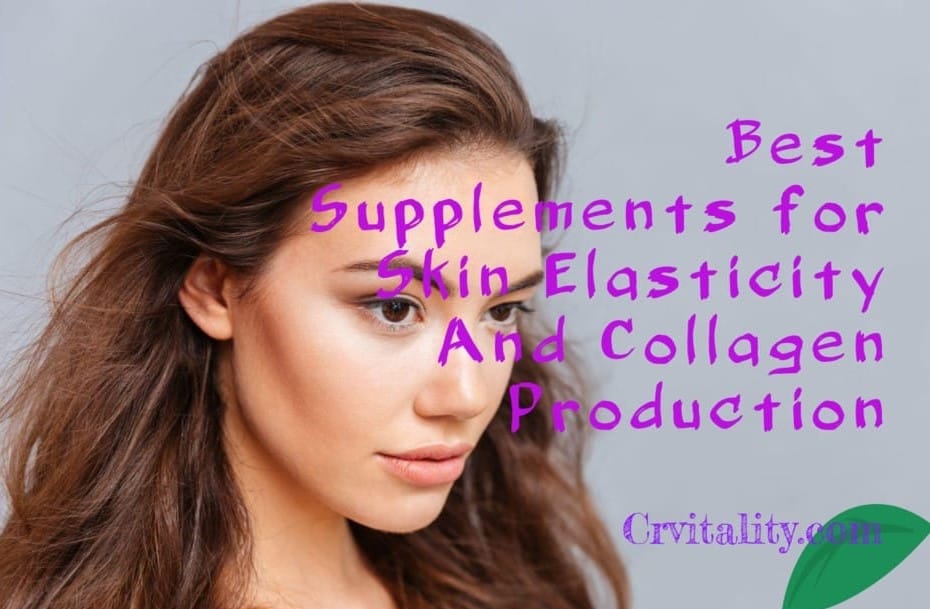
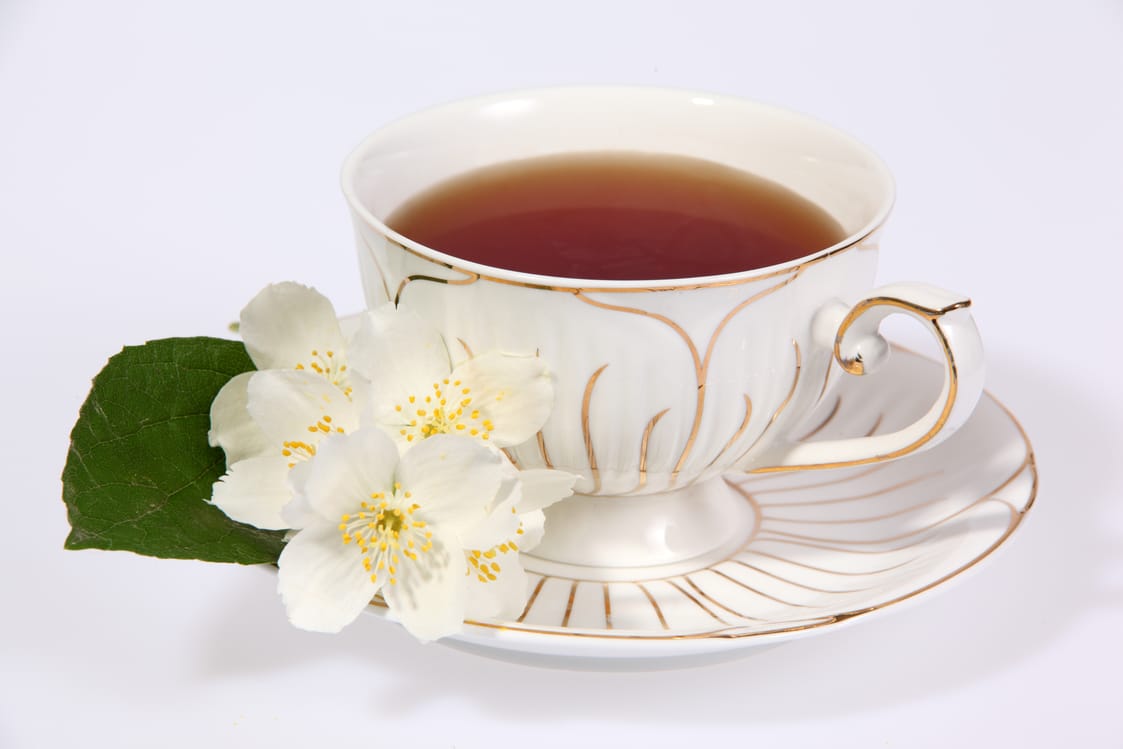
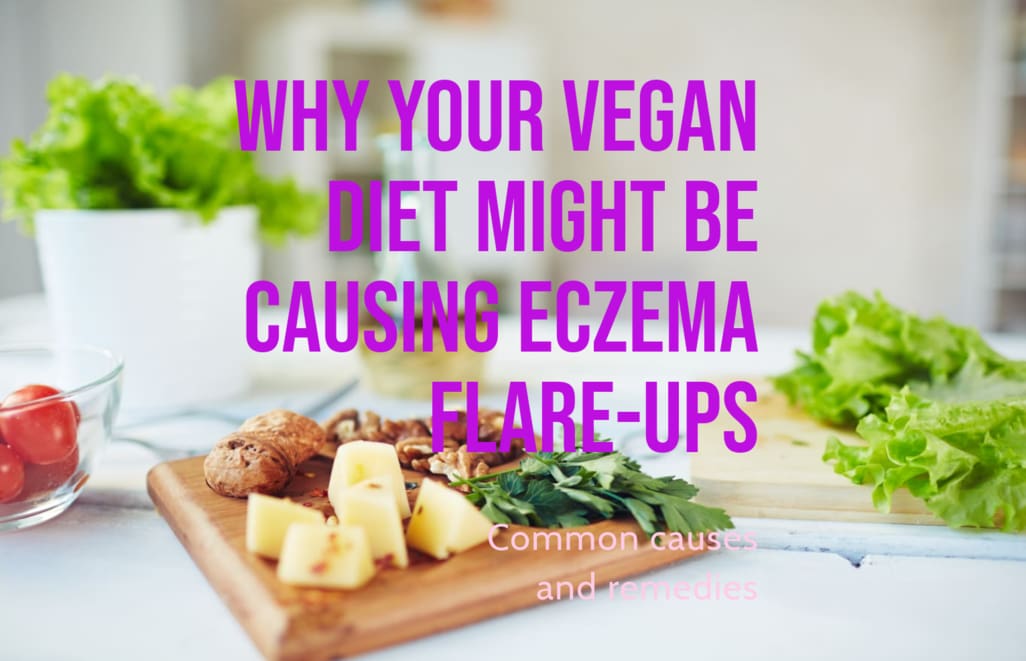
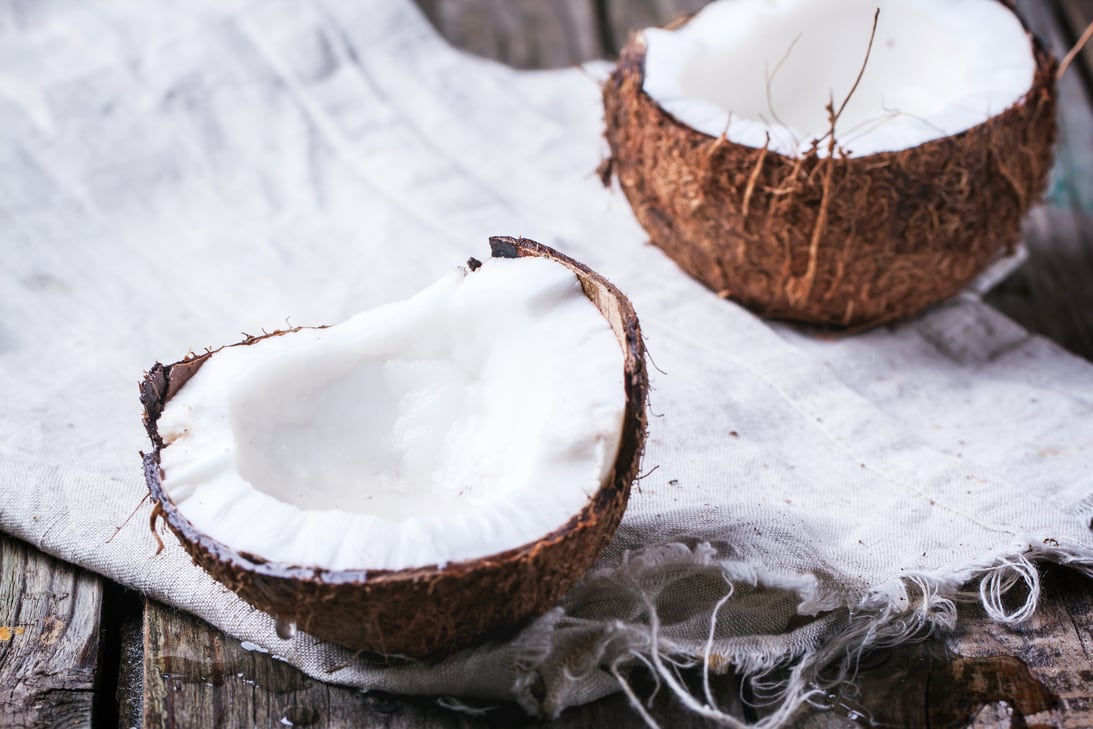

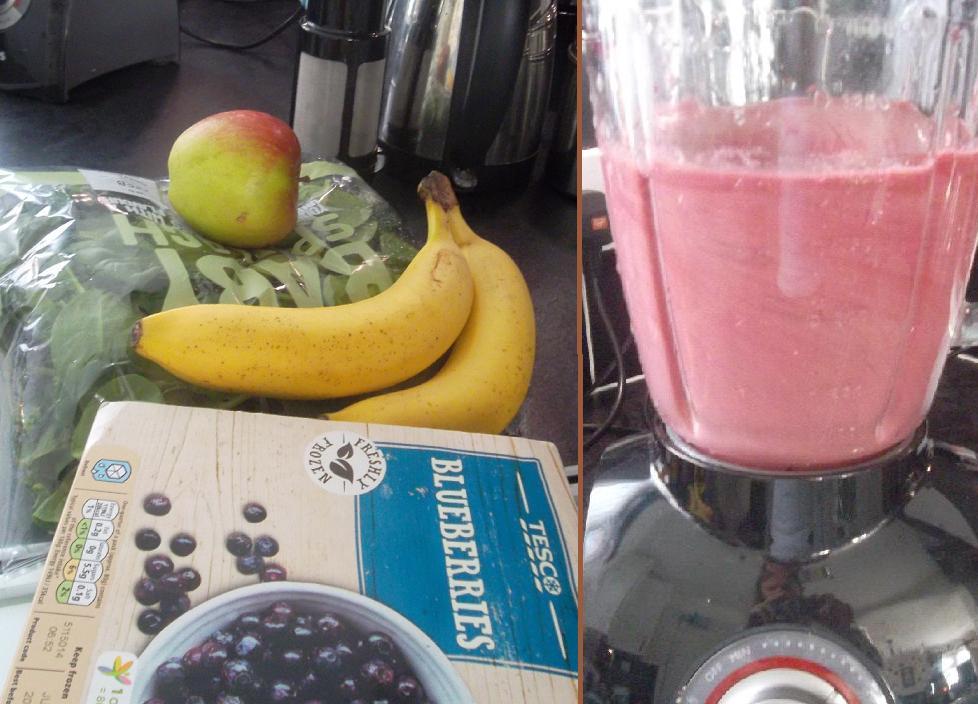
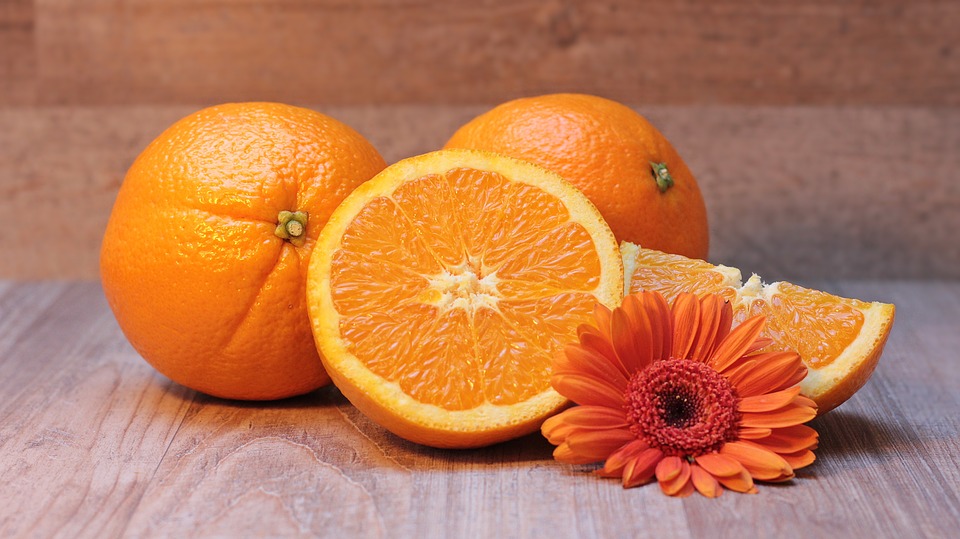
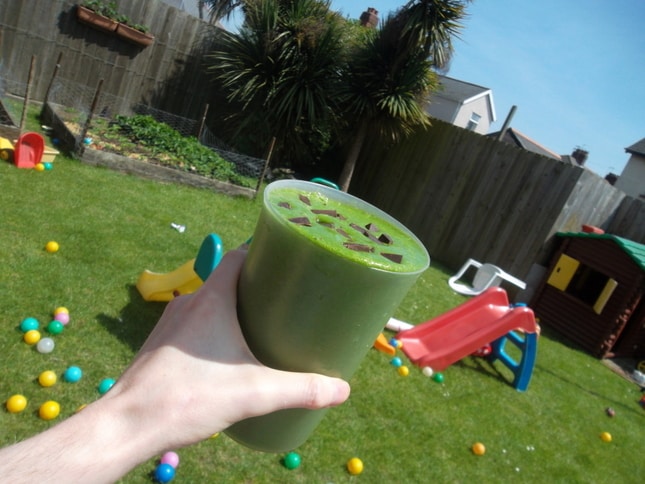
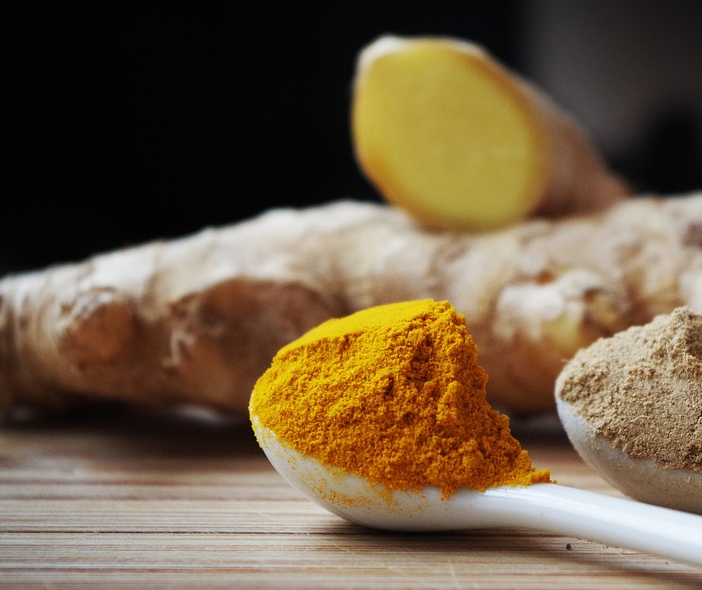
great post!
Although for some people like me, ANY product is worse for the skin than none.
I have tried many sunscreens, many natural oils(primrose, jojoba, rosehip, etc…). And what happens? My skin for example on forehead statrs to appear a little leathery. It is very odd.
And then when I stop using it, my skin becomes normal again. This is especially the case when using oils on the face or moisturizers. I can’t explain it :p
Nice post!
Question Matt,
You recommend 5-10 cups of green tea. Even if you happen to stay away from fluoridated water. Aren’t you worried about the fluoride content of tea? I’ve seen some studies showing levels of fluoride to be high in even one cup of tea.
Not really. There are studies showing up to 10 cups of tea is beneficial when it comes to longevity. But I probably should try to get my tea from better sources, like Japan.. which has less fluoride.
I think I have really come on the right place for getting the perfect info. anti aging products
I think this is one of my favorite blog ever 🙂
Hi Matthew
I saw your post in Dr Mintz blogspot on your adverse side effect which i found to be very similiar to mine.
I know you wrote that on July 18, 2008. And i hope you are totally cured now! 🙂 Can i know if your vision problem, muscle joint pain and tendon pain is resolved by now?
Yes like you, we eat healthily and do yoga , never drink or smoke before Cipro hits us real hard.
Cheers to your anti aging diet! 🙂 and not forgetting collagen helps too 🙂
Best of health to everyone,
Jarene
Hi Matthew again,
Sorry i just realize the google account i signed in belong to my brother ! 😛 he left his account switched on so i didn’t know it’s tagged to his.
My name is Jarene and nice meeting you!
Best
Jarene
Good and healthy food is prerequisite foe younger looking skin. There are a wider number of foods and vegetables that can do wonders for your skin.
Food for good looking skin
Argan oil contains lots of antioxidants like Vitamin E that fights for free radicals which can seriously damage your skin and lot more. So you can check best Argan oil products at Buy Argan Oil for Face
Great post I think is not good for 5-10 cups of tea I think is so much but that is my opinion
Why do you think it’s too much? Have a look at this post http://inhumanexperiment.blogspot.co.uk/2009/01/drinking-10-cups-of-green-tea-daily-and.html
I’ve been drinking this much tea for the past 12 years now. It seems to be fine. 🙂
Plus there is a good amount of scientific evidence to suggest that drinking up to 10 cups of tea is more protective than 5 or less.
This is one amazing blog thanks for share
hanks for the great article Life Expansionists are at the forefront when it comes to taking protective measures against the physical and mental decline that occurs with Anti Aging . While many individuals faced with the prospect of aging are consistent users of antioxidants,
hanks for the great article Life Expansionists are at the forefront when it comes to taking protective measures against the physical and mental decline that occurs with Anti Aging. While many individuals faced with the prospect of aging are consistent users of antioxidants,
Such a very informative and useful post. I agree with you, there are so many anti-aging foods that you should indulge in to get fair, younger looking skin.
All the best!
Shruti
Your blog is absolutely terrific! Thank you for such great advice. Pam
Thank you! 🙂
Nice post (although after all these years of studying health I have already seen these of course.) This is a GREAT list however for those who eat crap. Funnily enough these are my favorite foods (except avocado.) You should give perhaps some links to great recipies (I love sweet potato and kale chips with olive oil, turmeric, hot pepper, all kinds of healthy spices). And I SO agree that doctors who say there is no link between the outside and inside are FULL OF IT.
I haven’t had Avocado in quite a while, actually. You’ve just reminded me to get some next time I’m at the store. 🙂 Yeah, I was meant to do that a while ago, sorry…
I’ve never actually tried Kale Chips before… Do you order them online or?
I just turned 27, while I was blessed with good genes (thank you God),which have kept me looking like a teenager way beyond the years, I’m starting to feel the effects of age. I’m so pleased to have found your website. Please never ever shut this down. It has a wealth of information and you’re proof of your own words. Its a pleasure reading your blog.
Hi. Thank you for reading! 🙂 I’m glad you find the information here useful… I definitely won’t be closing this site, don’t worry. In fact, I’ve decided to develop it a lot over the coming weeks and months. So keep an eye out! And I hope to see you around… Have a great day! 🙂
[…] Essential Oils for Summertime fun!!! | The Yogi Tree Center for GrowthHoney: a sticky love story – Amazingy MagazineSunshine & Exercise | The Juice ClubThe Juice ClubItchy Scalp – Causes, Treatment and Home RemediesHow to look younger | CR Vitality […]
i can see many wrinkles on my face. What is to be done for quick wrinkle free treatment.